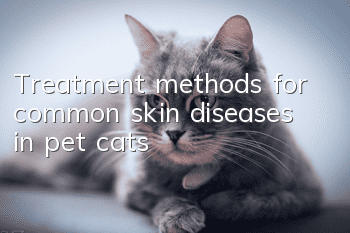Treatment methods for common skin diseases in pet cats

Cat skin diseases mainly include:
a) Bacterial skin disease: mainly bacterial infection;
b) Fungal skin disease: caused by fungal infection of the skin; skin fungi survive for a long time in nature, have strong resistance, and can survive for more than 1 year in a dry environment. There are also some fungi that have an affinity for soil and can grow and reproduce in the soil and survive for a long time.
c) Ectoparasitic skin diseases: caused by fleas, scabies, demodex, ear mites, lice, ticks, etc.;
d) Metabolic dermatoses: hormonal dermatoses; allergic dermatoses;
e) Immune abnormality skin diseases: nutrition-related skin diseases, etc.
Among them, fungal skin diseases account for more than 80% of cases, and more than 98% of pathogenic cat fungal skin diseases are caused by Microsporum canis, which is a kind of fungal skin disease that can occur in dogs, cats, and humans. Possible infectious diseases, commonly known as fungal infections, or "ringworm." Human dermatologists often misdiagnose allergic dermatitis caused by cat hair, causing many owners to give up their cats.
Fungal skin disease
The main route of transmission of dermatophytes is contact infection, which can be transmitted through pollutants in cats’ sleeping areas and contaminated combs, brushes, bedding and other media. This disease can occur all year round, and the incidence is generally higher in hot and humid climates. Cats that have recovered from fungal disease are resistant to reinfection with the same fungus, but the resistance will disappear after a few months to a year. The fungus is a zoonotic skin disease, and children and women are more susceptible to it.
Symptoms
When cats suffer from fungal skin infections, they mostly occur on the head, ears, limbs, toes, and trunk. The skin of the affected area becomes hairless, with ring-shaped scaly spots appearing, and damaged hair roots remaining. Sometimes the affected area is completely hairless. In severe cases, erythema or scab may form. When hair begins to grow in the middle of a ringworm patch, hair loss continues around it. The affected area is itchy. If some cats are scratched and secondary bacterial infection occurs, the exudation will be severe. Redness, swelling and erosion of the skin can be seen, and in severe cases, it may become suppurative. The development of dermatomycosis generally spreads from the middle to the surrounding areas. If not treated in time, it will become chronic and have a long course.
After the above symptoms appear, take the cat to the veterinary hospital for examination.
Treatment
1. Local treatment: external drug treatment
It is recommended that long-haired cats have their entire body shaved, while short-haired cats should shave the hair within six centimeters in diameter of the lesion. Special care should be taken not to scratch the skin when shaving to avoid the spread of the lesion.
For topical drugs, it is recommended to use Xingfenjing and Xingfengjing. If it is yeast, ketoconazole should be chosen.
On topIt is better to wash the local skin with sulfur soap before applying the medicine, and then apply the medicine. Use a cotton swab dipped in alcohol to wipe away the skin flakes and hard scabs in the sick area, and then apply topical antiseptic drugs 2 to 3 times a day. The area of application extends 6 cm in diameter outside the sick area, including the surrounding seemingly healthy skin. , so that the drug can directly penetrate the skin of the affected area.
In addition, follow the instructions on the medication, especially the frequency of use.
TIPS: Do not use daxonine cream on cats (the effect of the drug is not obvious, slowing down the treatment and causing expansion), clotrimazole (cats can easily cause drug poisoning and blindness after licking it).
2. Systemic treatment: If there is still no significant improvement after 2 to 4 weeks of local treatment, it is recommended to switch to oral drug treatment.
When giving medicine to cats, basically follow the principles of giving medicine to babies. Be sure to control the weight ratio, and generally there will be no problems.
1) Griseofulvin
Griseofulvin tablets 30 mg/kg body weight, once a day for 3-4 weeks, can inhibit the development of deep hairy root fungi. However, it may be toxic to cats, especially Persian cats, Himalayan cats, Siamese cats and Abyssinian cats, and cats with post-infectious immunodeficiency syndrome (HIV, feline AIDS) take griseofulvin The side effects are more serious and should be avoided; griseofulvin is teratogenic and should be avoided in pregnant female cats. In addition, cats taking griseofulvin should avoid direct exposure to sunlight, which may cause photosensitivity.
Kittens can only be fed griseofulvin after they are four weeks old, but they must be administered at the lowest dose (5-10/day) and pay attention to possible toxicity.
During griseofulvin treatment, add 4 ml of vegetable oil to cat food every day to promote the absorption of griseofulvin.
2) Traditional Chinese medicine: Smilax qian; Fangfeng qian; Shuanghua - qian; Lulu - qian; Licorice - qian and a half.
3. Nursing:
1)Sunshine
Many people think that ultraviolet rays in sunlight can kill mold. This statement is not wrong, but if it is used on cats, it must be considered, because to kill mold using ultraviolet rays, cats must be exposed to the sun for a long time, and cats It does not have sweat glands and relies entirely on the mucous membranes of the mouth, tongue and soles to dissipate heat. Long-term exposure may cause heat stroke and sunburn. If there is a window sill at home that can receive a period of sunshine every day, arrange a resting place for the cat there. You can look at the scenery outside and bask in the sun. It is important to stay dry.
2) Mu Yu
For infected cats, it is best to use special shampoo or sulfur soap for a long time. It is recommended to use it once every 1 to 3 days. Special shampoos and sulfur are very safe for kittens.
- What should you do if your cat has a fever? What to do if your cat has a cold or fever!
- How to make a cat vomit hairballs? How to prevent hairball disease
- American Wirehair Cat Training Methods
- What color is a British shorthair cat?
- What is the favorite food of exotic shorthair cats? How much do you know about feeding shorthair cats?
- Is it because the hairless cat has diarrhea because there are worms in its stomach? The poop scraper comes in to take a look!
- How many months do you need to start vaccinations for cats?
- Cat urinary system problems, how to prevent and treat them?
- How to take care of your new Garfield cat?
- There are many benefits of keeping pets, including health, stress relief and happiness



